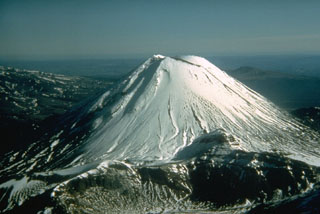Report on Tongariro (New Zealand) — 7 November-13 November 2012
Smithsonian Institution / US Geological Survey
Weekly Volcanic Activity Report, 7 November-13 November 2012
Managing Editor: Sally Sennert.
Please cite this report as:
Global Volcanism Program, 2012. Report on Tongariro (New Zealand) (Sennert, S, ed.). Weekly Volcanic Activity Report, 7 November-13 November 2012. Smithsonian Institution and US Geological Survey.
Tongariro
New Zealand
39.157°S, 175.632°E; summit elev. 1978 m
All times are local (unless otherwise noted)
On 5 November, GeoNet reported that several teams of scientists had been visiting Tongariro's Te Mari Craters to service portable seismometers (complementing four permanent installations), sample gas vents, and collect samples of ejecta. The report noted that not many earthquakes had been recorded recently, and that the hottest gas vent was 235 degrees Celsius while the others ranged from 95-104 degrees. On 30 October the sulfur dioxide flux was 154 tonnes per day and the carbon dioxide flux was 477 tonnes per day. The volcano continued to actively degas. The Aviation Colour Code remained at Yellow and the Volcanic Alert Level remained at 1 (signs of volcano unrest).
Geological Summary. Tongariro is a large volcanic massif, located immediately NE of Ruapehu volcano, that is composed of more than a dozen composite cones constructed over a period of 275,000 years. Vents along a NE-trending zone extending from Saddle Cone (below Ruapehu) to Te Maari crater (including vents at the present-day location of Ngauruhoe) were active during several hundred years around 10,000 years ago, producing the largest known eruptions at the Tongariro complex during the Holocene. North Crater stratovolcano is truncated by a broad, shallow crater filled by a solidified lava lake that is cut on the NW side by a small explosion crater. The youngest cone, Ngauruhoe, is also the highest peak.
Source: GeoNet

